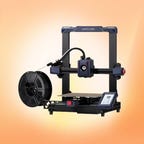Best Budget 3D Printer: 7 Great Printers at a Price You'll Love
The best 3D printer is the one you can afford. These are printers to suit folks on a tighter budget.
 Why You Can Trust CNET
Why You Can Trust CNET
Did you know that a large amount of creative Americans refer to themselves as "makers" (about 135 million -- if you're interested in stats)? A major portion of them have tapped into the awesomeness of 3D printers. That means a lot of amazing things have been physically brought into the world through a simple machine. What kind of awesome things, you ask? With a 3D printer, you can build small statues to give as gifts or cultivate epic pieces of costume armor. The possibilities are practically limitless. In fact, you can even tap into your creative side by opening your own Etsy store. Equipping yourself with a few printers will get you well on your way to turning your hobby into a revenue stream.
Using a 3D printer used to feel completely out of reach. You can find solid printers available for under $300, making it easier than ever to step into the "maker" realm. There is a catch: These budget machines usually need to be tweaked and tooled to get it just right. You'll save money, but it's a rough-and-tumble way to get started. The best budget 3D printers have a healthy balance between usability and cost, so that's what we're looking at in this list.
What's the best budget 3D printer?
Budget 3D printing is a category that is growing fast. For my money, the best you can buy right now is the Anycubic Kobra 2. It has enough upgraded features to make it an incredibly useful machine. Its price was recently slashed to $209 from its previously firm-set price range of $250-$280. Having this much quality in a printer that costs so little makes it the perfect budget 3D printer.
These budget 3D printers all cost under $500 (though prices can drift a bit month to month), and some are better suited to beginners than others. Our list of picks for the best 3D printer overall covers a much wider range of choices, but these are excellent for getting started -- or for buying several at once. If you are thinking of creating a print farm, then buying several Anycubic Kobra 2's is an excellent way to get started.
Best budget 3D printer
The big selling point for the Kobra 2 is the price. It has all the advantages of a faster printer but with a sub-$300 price tag, which is astonishing. This is my recommendation for any first-time buyer or someone on a budget.
" page-position="" linktext="" linkurl="" can-collapse="true" collapse-on-page-load="true" can-truncate="true" truncate-on-page-load="true" offer="" techobjectinfo="" overridecredit="Anycubic" overridecaption="" imagegroup="{"uuid":"aca113aa-9220-419e-9cdb-10b5794670af","alt":"Anycubic Kobra 2 on an orange background","caption":"","credits":"Anycubic","imageData":{"id":"aca113aa-9220-419e-9cdb-10b5794670af","filename":"anycubic-kobra-2-promo.jpg","path":"https://www.cnet.com/a/img/resize/1757fec86dbf41de8ef32ea69d67bef83cedf1ef/hub/2023/07/05/aca113aa-9220-419e-9cdb-10b5794670af/anycubic-kobra-2-promo.jpg?auto=webp&height=500","dateCreated":{"date":"2023-07-05 20:26:35.000000","timezone":"UTC","timezone_type":3},"primeColor":null,"hasWarning":false},"size":"","float":"","lightbox":false,"imageUrl":"https://www.cnet.com/a/img/resize/1757fec86dbf41de8ef32ea69d67bef83cedf1ef/hub/2023/07/05/aca113aa-9220-419e-9cdb-10b5794670af/anycubic-kobra-2-promo.jpg?auto=webp&height=500","imageCaption":"","imageCredit":"Anycubic","imageAltText":"Anycubic Kobra 2 on an orange background","imageFilename":"anycubic-kobra-2-promo.jpg","imageWidth":1600,"imageHeight":900,"imageDoNotCrop":false,"imageDoNotResize":false,"imageWatermark":false,"imageDateCreated":"2023-07-05","imageParallax":"","imageCrop":"","imageEnlarge":false}" usepricing="true" ng-block="{"id":"7cwynxtkoo43swd","type":"cross-content-listicle"}" edition="us" data-key="cross_content_listicle__1ae7fe99-ba24-468a-9126-1b104f8e8aea" imagecredit="Anycubic" tagslugs="hv28,3d-printing" contenttype="Best List - Precap" isbestlistredesign="true" filtershortcodetypes="" totalfilteritems="0" pagelayout="Best List - Precap" showdetails="true" tocheadlineitem="[object Object]" class="c-bestListProductListing">While not as fast as the P1P or the X1C from the best 3d printer list, the Kobra 2 is around the same speed as the AnkerMake M5. It will happily produce prints at 250 millimeters per second, although the best quality seems to be hovering around 150mm/s in my testing. It also comes with a filament runout sensor and bed leveling, which works extremely well.
The big selling point for the Kobra 2 is the price. It has all the advantages of a faster printer but with a sub-$300 price tag, which is astonishing. This is my recommendation for any first-time buyer or someone on a budget.
Joint best budget 3D printer
Elegoo Neptune 4 Pro
The Elegoo is one of my favorite ultracheap printers. When testing it, I kept expecting it to fail, and it just didn't. It produced amazing results for the price and continues to do so every time I use it. Whether you buy the Anycubic Kobra 2 or the Elegoo Neptune 4 Pro, you are getting the best 3D printer for under $300.
Best color-ready fast 3D printer
Bambu Lab A1 Mini Combo
The A1 Mini Combo is an almost perfect entry to the world of color 3D printing. It's well-priced, and while the build area is small, the print quality and the fact that you can print in four colors straight out of the box is amazing. This is a no-brainer if you're looking for your first printer and want to try color printing.
Fast and stable budget 3D printer
AnkerMake M5C
Anker did way more than take its excellent M5 printer and remove a few things to create a budget-friendly model. In fact, there are a couple of ways in which this budget bed-slinger improved over the original. The slightly smaller build platter offers guard rails so it's much easier to get it on and off the heated base. The camera and display have been removed, but the AnkerMake app is one of the best pieces of software available for any 3D printer and has a much nicer interface. Perhaps best of all, the new all-metal hot-end means it can handle a larger array of materials when printing. At its core, it's still a rock-solid printer with some of the most user-friendly apps you can get today.
Excellent out of the box
Flashforge Finder 3
I've recently been working with the Finder 3 and I'm impressed with the quality it was able to produce straight from the box. It is easy to set up and comes with a flexible build plate that you can replace the glass bed with. It makes it far easier to remove builds. Overall, the Finder 3 is a great printer for the price. It's perfect for a teacher in the classroom as the enclosure makes it stable, and the slicer can control multiple printers at once via Wi-Fi.
Best budget resin 3D printers
Most beginner printers use a plastic filament to create models, but plenty of affordable resin 3D printers are available, too. Liquid resin is a little more difficult to use than standard 3D printing material and requires safety equipment, but it also produces amazingly detailed results.
The best starter resin printer
Elegoo Mars 3
This small resin printer is Elegoo's latest model in its popular Mars line. Because of the 4K monochrome LCD (these printers use light from an LCD to cure liquid resin), it can print much faster than older printers. Standard 3D printing simply can't reproduce the level of detail on models. At this price, the Elegoo Mars 3 is the best resin printer for the money.
Best midsize budget 3D printer
Elegoo Saturn 2
The Elegoo Saturn 2 is my favorite resin printer right now. It prints detailed models at a speed that's often astonishing. The bed size is much larger than the printers in the smaller category, while its footprint is much easier to deal with than other, larger printers. You can print finely detailed cosplay pieces or multiple tabletop miniatures with equal ease with the Saturn 2, making it perfect for a small business.
Read more: Elegoo Saturn 2 Review
Budget 3D printer FAQ
What material should I use to print with?
What settings should I use?
What are supports?
How we test 3D printers
Testing 3D printers is an in-depth process. Printers often don't use the same materials, or even the same process to create models. I test SLA 3D printers that use resin and light to print, and FDM printers that melt plastic onto a plate. Each has a unique methodology. Core qualifiers I look at include:
- Hardware quality
- Ease of setup
- Bundled software
- Appearance and accuracy of prints
- Repairability
- Company and community support
A key test print, representing the (now old) CNET logo, is used to assess how a printer bridges gaps, creates accurate shapes and deals with overhangs. It even has little towers to help measure how well the 3D printer deals with temperature ranges.
When testing speed, we slice the model using the standard slicer the machine is shipped with on its standard settings, then compare the real-world duration of the print to the statement completion time on the slicer. 3D printers often use different slicers, and those slicers can vary wildly on what they believe the completion time to be.
We then use PrusaSlicer to determine how much material the print should use and divide that number by the real-world time it took to print to give us a more accurate number for the speed in millimeters per second (mm/s) the printer can run at.
Every build plate is supposed to heat up to a certain temperature so we use the InfiRay thermal imaging camera for Android to check how well they do. We set the build plate to 60 degrees Celsius -- the most used temperature for build plates -- waited 5 minutes for the temperature to stabilize, and then measured it in six separate locations. We then took the average temperature to see how close the 3D printer got to the advertised temperature.
Testing resin requires different criteria, so I use the Ameralabs standard test: printing out a small resin model that looks like a tiny town. This helps determine how accurate the printer is, how it deals with small parts and how well the UV exposure works at different points in the model.
Many other anecdotal test prints, using different 3D models, are also run on each printer to test the longevity of the parts and how well the machine copes with various shapes.
For the other criteria, I researched the company to see how well it responds to support queries from customers and how easy it is to order replacement parts and install them yourself. Kits (printers that come only semi-assembled) are judged by how long and difficult the assembly process is and how clear the instructions are.






